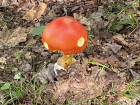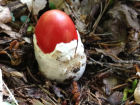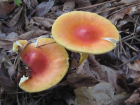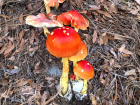Cap starts as an oval shape and then becomes convex, usually with a bump in the centre. It is sticky when fresh and has a bright red or orange colour that fades to orange or yellow towards the margin. The surface of the cap is smooth, without warts or patches. The margin is lined with long streaks that extend inward from the lighter coloured edge of the cap. The flesh is whitish to pale yellow, not staining on exposure. Gills moderately crowded to crowded, orange-yellow to yellow-orange to yellow. They are free from the stem or slightly attached to it. Stem yellow with orange to reddish fibres, typically slender, slightly tapering upward. The interior is hollow and has a yellow membranous ring near the apex. The volva is large, white and sacklike. Spore print white.
Microscopic Features: The spores are ellipsoid in shape, measuring 8-11 µm in length and 5-6.5 µm in width. They have a smooth surface and are inamyloid.
Similar species include Amanita caesarea which is found in Europe and North Africa and Amanita muscaria which sometimes lack patches because the rain has washed them away.
Amanita jacksonii on the MushroomExpert.Com Web site.
Many mushrooms are poisonous, and some can be lethally toxic. Distinguishing between edible and poisonous mushrooms can be very challenging. Therefore, we strongly advise against consuming wild mushrooms. This website does not contain any information about the edibility or toxicity of mushrooms.
Although efforts have been made to ensure accuracy on this website, the information may contain errors and omissions. Therefore, all content provided is for educational and informational purposes only and should not be relied upon or used as a basis for consuming any plants or mushrooms.
External links are provided for reference only. We do not endorse or take responsibility for the content, advice, or products found on these sites or in any advertisements shown on this website.



